free & fun
Upcycled Tote Bags
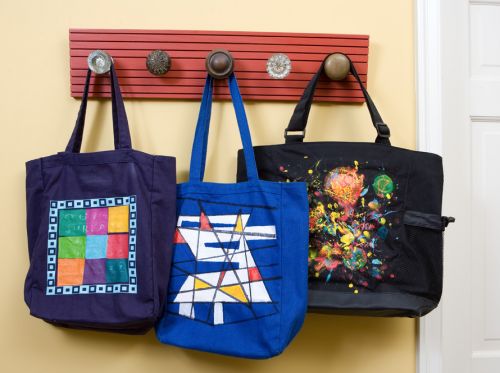
Let the art masters inspire you as you reinvent your logoed bags!
What you'll need
Tote bag with a logo you'd like to hide
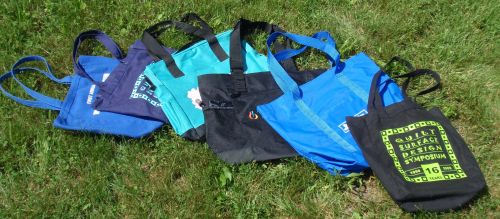
Concentrated acrylic craft paint or fabric paints for good coverage in assorted colors
Small paintbrushes, flat and tapered
Round sponge applicators in various sizes, such as Spouncers
Permanent ink felt tip markers
Duct tape
Plastic cloth to protect tabletop surface, plastic gloves; plastic or aluminum pans or trays; plastic spoons and drink stirrers
Optional: compressed sponges, corks, potato masher, pencil erasers
Color play
1 Protect work surface with an old shower curtain or plastic tablecloth. Insert cardboard into bag to keep paint from seeping through to the other side. Wear plastic gloves. Keep rags and paper towels handy for correcting spills and drying brushes. Have jars of water available to keep brushes with paint on them from drying out.
2 Use disposable aluminum pie pans, foam meat trays, plastic egg cartons, margarine containers and lids for paint palettes. Mix paints with a drink stirrer or spoon. You can dip small paintbrushes into paint jars, but for stamping or mixing colors, spoon about a 1/2 teaspoonful of paint onto palettes.
3 Keep brushes, sponges, and other paint applicators nearly dry when dipping them into paint. Apply thin coats of concentrated color to bags.
4 If your bag is vinyl or plastic-coated, let painted surfaces "cure" for 24 hours before using. Be gentle when spot-cleaning or washing your bag and perform touch ups if paint flakes or wears off.
5 If your bag is cotton, linen, or synthetic, heat-set the painted design, spreading a pressing cloth on top and applying a hot dry iron for 2-3 minutes on each area.
Camouflage tactics
1 First, consider how to best cover up the logo and other printing on the bag. Use strips of duct tape to mask those areas you do not want to paint. Be sure to press firmly along the edges of the tape to prevent paint from seeping underneath.
2 Paint over the logo with a color that is darker or more intense than the printing and the bag. Or, try white fabric paint, which in some brands such as Neopaque, provides better coverage than colors. Let the paint dry and apply a second and even a third coat.
3 If the printing is raised, it will always show through, especially with a flat application of one color. Various dots, spots, dashes, and lines will provide a visual texture to counteract the raised texture.
Arty-Smarty Bag a la Paul Klee:
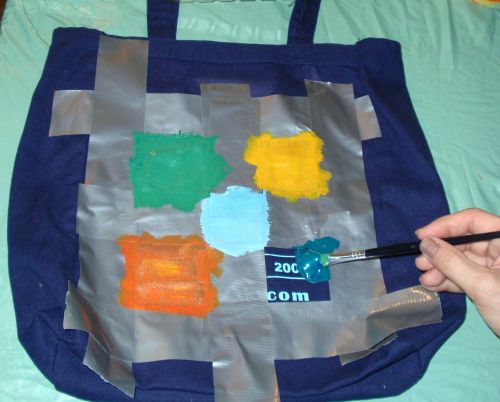
A la Paul Klee: Emulate this artist's famous magic squares series with a multicolored grid. First, cut strips of duct tape to mask a center square and four corner squares, plus the fabric beyond the grid. Mix up a variety of paint colors, and give each exposed square two or three thin coats of a different color, letting dry after each coat. Peel off the tape, and reapply it to mask all but the center of each side of the square. Paint as before, then remove the tape. Voila! An Amish-style Nine-Patch or a tic-tac-toe board for nickel and dime-yielding gamesters.
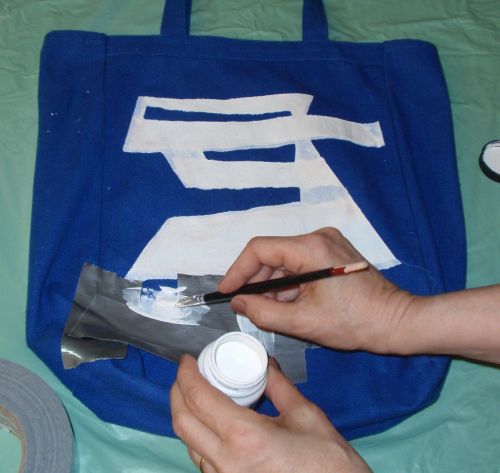
A la Piet Mondrian: Mask straight lined shapes around the logo, and paint over with several coats of white. When dry, remove the tape. Do touch-ups as necessary. Use a ruler and permanent ink felt tip marker to draw lines criss-crossing the painted areas. Finally, dip fine brushes into primary colors and apply several coats over one or two of the small white areas.
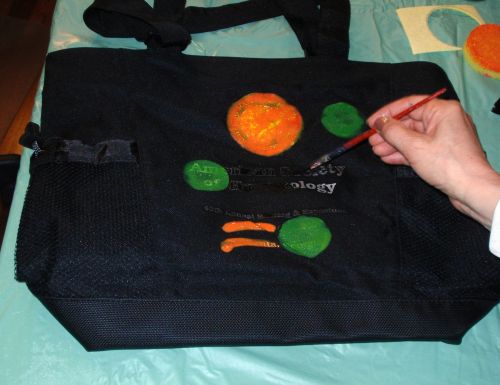
A la Jackson Pollack: Start by covering up the densest areas of printing, stamping with large circles or amoeba shapes cut from compressed sponges. Next, paint over the text in a color to match the bag, or simply camouflage the text with different bright colors. Now for the wild and crazy part: this is messy, so tape mini-drop-cloths over any parts of the bag where you don't want paint. Then go to town: Dab, drip and spatter paint randomly. Load up brushes with paint, and then tap the handle to flick paint onto the surface. Use sponges to absorb excessively large gobs of paint, because these will take forever to dry. Avoid moving the bag until all paint marks are thoroughly dried.

